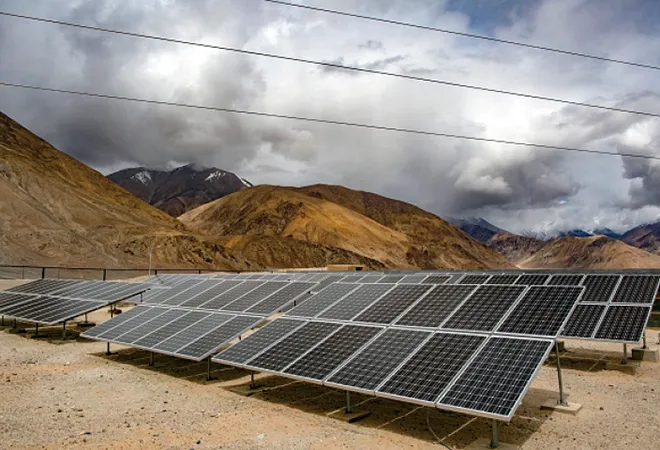
As countries around the world prepare to reboot their economies post the COVID-19 pandemic, a clear shift in perspectives on economic growth is evident. Instead of giving in the short term temptation of keeping climate action in the shadows, it is now in the frontline of economic recovery plans. On March 26, EU leaders re-committed the ‘European Green Deal’ (aimed at making EU the first carbon-neutral continent), that was negotiated in the early months of 2020, and positioned it as the framework to rebuild the economy after the pandemic. Public backing to climate action is also visible. South Korea's Democratic Party which had placed a European style green deal as a part of its ‘Korean Plan’ in its manifesto, won a landslide in elections that took place in April this year.
The COVID-19 pandemic also offers an incredible opportunity to debate India's growth model. Should we go back to a model which has delivered an import-dependent, highly polluted, fossil-fuel guzzling economy, with dwindling employment potential, depleting natural resources and widespread geographical and income disparities; or to rebuild based on a qualitative growth model which is climate neutral, but at the same time reduces dependency on imports, supports greater levels of employment, improves the quality of life of its people and strengthens the vision of a more resilient economy. The vulnerabilities of our economy and health infrastructure exposed by COVID-19 should be a lesson to avoid a much bigger problem called the ‘climate emergency’. and the short term silver lining of the pandemic in the form of decreasing air pollutants, as a result of a temporary halt in anthropogenic activities, should inspire us to choose the latter.
Prime Minister Modi announced the Atmanirbhar Bharat Abhiyan (self-reliant India mission) on May 13. The 20 lakh crore package (approximately 10% of India's GDP) unveiled thereafter by the Finance Minister includes several monetary and fiscal measures as well as reforms covering various sectors and sections of the economy including agriculture, MSMEs, health, education, rural economy, migrant workers and street vendors. However, it seems that we may have missed a propitious opportunity to pivot to renewable energy. Solar energy generation and solar equipment manufacturing sectors, which can deliver the co-benefits of securing India’s energy future, reducing India’s dependence on imports (both fossil fuels and solar equipment), delivering incremental job opportunities, and carbon-neutral economy have not received the importance that is due to it, in the ‘Atmnanirbhar package’.
It is a fact not unknown to many that with 300 clear sunny days in a year and with a calculated solar energy incidence on India's land area at about 5000 trillion kilowatt-hours (kWh) per year, the solar energy available in a single year exceeds the possible energy output of all of the fossil fuel energy reserves in India. So the question is, whether India is punching at its weight in terms of solar power? Indeed, by committing to upgrading its renewable energy capacity to 175 GW, of which 100GW would be solar, under the Paris agreement, India has demonstrated its commitment to decarbonize the economy. However, with an installed solar capacity of only 33.7 GW as of December 2019, we are very far from the goal. Installing more than 20GW of solar power every year to achieve the goal might seem like an insurmountable task, but is a viable antidote to resurrect a struggling economy post-COVID-19.
It is a fact not unknown to many that with 300 clear sunny days in a year and with a calculated solar energy incidence on India's land area at about 5000 trillion kilowatt-hours (kWh) per year, the solar energy available in a single year exceeds the possible energy output of all of the fossil fuel energy reserves in India
India’s average power per capita consumption at 1,181 kWh is one of the lowest in the world. With an energy generation potential of 749 GW (estimates by National Institute of Solar Energy), high speed and scale (a 500 MW capacity can be constructed within 18 months while a similar thermal or hydro plant might take 2-3 times more) and lowest cost structure (India has emerged as the world’s cheapest producer of solar power with tariff’s as low as 2.44/KWh and costs of construction and financing for a new plant 14% below that of coal); solar is a viable alternative to secure India’s energy needs.
About 79% of India’s energy generation is from fossil fuels and the country is largely dependent on fossil fuel imports to meet its energy demands – by 2030, India's dependence on energy imports is expected to exceed 53% of the country's total energy consumption. High commodity price cycles and geopolitical tensions, constrain supplies and make imports prohibitively expensive. A higher share of solar in India’s energy mix will reduce the dependence on fossil fuels, thereby curtailing the import bill and resultant dilution of forex reserves.
Despite the ambitious target of solar power generation, India has an annual solar cell manufacturing capacity of about 3 GW while the average annual demand is 20GW. Seven of India’s top 10 module suppliers are Chinese firms. In the past five years, India has already imported $16 billion worth of solar equipment, and unless indigenous capacity is ramped up, India may import an additional $42 billion of solar equipment by 2030. Indian manufacturers cannot compete on cost, and many have limited access to low-cost loans highlighting the need for a strategy to ramp up solar component manufacturing under the Make-in India initiative.
Solar PV is also recognized as creating more jobs per unit of energy produced than any other energy source. The central government had cited job creation as a rationale for the Solar Mission. It is estimated that by 2022, the solar energy industry would generate as many as 1.6 million jobs with over 600,000 jobs focused on the construction vertical alone. Since Renewable Energy is decentralized power, there are opportunities for generating jobs in villages. These being jobs that require high to minimal professional skills, there is employment potential for even those with limited educational opportunities along with the professionals.
The central government had cited job creation as a rationale for the Solar Mission. It is estimated that by 2022, the solar energy industry would generate as many as 1.6 million jobs with over 600,000 jobs focused on the construction vertical alone
To become ‘atmanirbhar’, we must withstand the temptations of short term solutions that lock-in a fossil fuel economy for years to come and focus on our strength which lies in renewables. Large scale deployment of solar will lead the economy to a sustainable, independent, and inclusive future. However, this would need bold and speedy policy actions to solve the problem of the high cost of funds, land acquisition issues, policy flip-flops by state governments, and access to technology.
The views expressed above belong to the author(s). ORF research and analyses now available on Telegram! Click here to access our curated content — blogs, longforms and interviews.




 PREV
PREV


